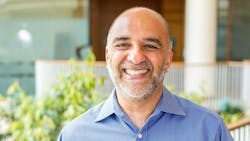National Coordinator for Health IT Micky Tripathi, Ph.D., notes that with so many documents still being faxed or printed out and handed to patients to convey to other provider organizations, many health systems still have lots of cultural work to do to fully take advantage of the interoperability now available to them through health information exchanges and national health information networks.
In a Feb. 22 conversation with Health Affairs Editor-in-Chief Alan Weil, Tripathi gave an example from his own personal experience. After his mother was in a hospital in Massachusetts with one EHR system, she was being transferred to a rehab hospital close by with a different EHR. Those systems are connected on the back end through a large national network, he said. “When my mother was being discharged, what did they do? They turned to me with a stack of paper and said, ‘Here is her medical record. Please bring it to the other place and they will scan it in.'”
Tripathi stressed that the interoperability capability is there. “This isn't blaming the frontline people. This is not their fault, right? But their organization has not taken the time, the effort to push that interoperability all the way down, so that it's easier for that frontline worker to say I'm going to do this electronically,” he said. “Their organizational instinct or workflow instinct is that I'm just going to print it off and hand it to them. So we have a lot of work to do to get that interoperability that's already there all the way down to the frontline and implemented fully. I highly urge every provider organization to ask yourself, are you doing that in your organization and if not, why not? Why are you allowing people to still fax when they don't have to fax? Just take it off the table as an option.”
With so much focus on social determinants of health, Weil asked Tripathi about interoperability of data on the human services front.
Tripathi mentioned that HHS and ONC are working with California and its Data Exchange Framework, which he described as a very ambitious set of initiatives that involves clinical interoperability. “They started with that, but they want human services interoperability as well. In working with them, we have aligned around this to say use TEFCA infrastructure and the top of the federal pipes, as it were, to solve your local needs as it relates to clinical interoperability, and then build on top of that to service state-specific requirements related to human services,” he explained. “They’re building additional capabilities and additional infrastructure — both policy and technical — on top of that to serve the human services interoperability that they want to advance in California. I think from a federal perspective, we see that as a great laboratory. California can move ahead with that and it will offer lessons learned to all of us. Once we get the clinical interoperability framework in place and really up and running, that allow us then to take some real lessons learned in a very complex state and apply that more broadly across the ecosystem nationwide.”
Weil noted that even the existence of that technology infrastructure is rare in the social services and human services world. “So you've got these standards and all of these data elements, but you don't have a computer or you have a low-speed internet connection,” he said. “You certainly don't have ICD codes and all of the other kinds of standardization that's occurred within healthcare.” He asked Tripathi if there is a comparable basic infrastructure agenda around the human services.
Tripathi responded that within HHS, ONC is starting to focus on human services data as well. “We're going to start working with our HHS agency partners who are in human services to start to standardize more and more of those data elements that will allow greater standardization, greater scalability and better integration of human services and healthcare,” he said, “But that's a long process. HHS leadership is very much supporting that, so I think there'll be more announcements to come on that.” He noted that this effort doesn’t solve the problem of agencies not having enough funding to purchase technology solutions and IT staff.
He said one of the things that could mitigate in overcoming that barrier is the move to more modern conventions for interoperability, namely, FHIR APIs. Requiring that EHR systems support that type of integration and interoperability opens up the opportunity to say that human services organizations don't need a full-blown electronic health record, he explained. “That is not a technology that's appropriate to their needs. They can have much more nimble, agile web type of applications, which are much smaller footprint and easier to develop, and much cheaper, but would allow them to have the capabilities to integrate with healthcare delivery systems, for example, because of the use of these more modern, very lightweight interoperability mechanisms that are widely used across the entire internet economy and are only now coming to healthcare.”
Weil sought to bring in the equity dimension because HHS regularly references equity as a priority. He noted that leaders of integrated health systems talk about transforming patient care and opportunities for using information in new ways. “It’s a lovely story to listen to. And for clinicians who are in those settings and environments and want to be in those environments, it can be very empowering," he said. "It does feel to me like we run risks of of exacerbating inequities between high-resource and low-resource or more integrated and less integrated systems.”
He asked if there is a danger of the rich getting richer and the poor getting poorer, that the potential of improvement and the business success in a high-resource environment could be great, but those who are serving populations reliant more on Medicare and Medicaid with lower payment rates may be unable to keep up, and the same thing is true on the human services front.
“The digital divide issues are real,” Tripathi responded. “There is no overnight fix to them, and there's no technology-only fix to them as well. I think it's just one thing that we need to recognize, that technology is not going to be a magic bullet that solves these kinds of issues, but we want to make sure that it helps and doesn’t add to the problem. We have tried to identify where we have lower adoption, less-resourced parts of our ecosystem and work with our HHS partners, for example, to try to leverage the authorities that we have and the programs that we have to be able to provide more resources for them to be able to invest in technology.”
Tripathi gave an example of the nationwide networks that are in place today. They do have a lot of interoperability going over them. They've been private sector-driven. But one of the things that they haven't been able to tackle is that something like 30 percent of hospitals aren't connected to any of those networks. “How do we identify who that 30 percent is? I'm going to guess that most of those are safety net hospitals in inner city environments and rural hospitals that have either scarce resources on the technology side, scarce resources on the human capital side, or some combination of both,” Tripathi said. “And interoperability is one of the things that is a luxury for them in terms of their day-to-day survival. That’s one of the reasons that we've tried to step in with TEFCA, to say that shouldn't just be an afterthought or something that we allow to languish, as we have, as an industry. We need to now shine a spotlight on it and say there's 30 percent there, and there may be levers that we can pull from the federal government that lifts them up and gets them connected to allow them to be on the path that we want them to be on.”


